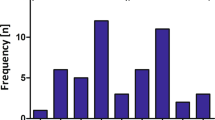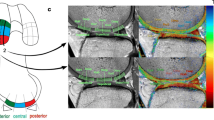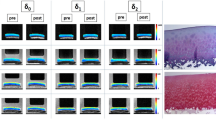Abstract
The aims of this study were to examine the clinical feasibility and reproducibility of kinematic MR imaging with respect to changes in T 2 in the femoral condyle articular cartilage. We used a flexible knee coil, which allows acquisition of data in different positions from 40° flexion to full extension during MR examinations. The reproducibility of T 2 measurements was evaluated for inter-rater and inter-individual variability and determined as a coefficient of variation (CV) for each volunteer and rater. Three different volunteers were measured twice and regions of interest (ROIs) were selected by three raters at different time points. To prove the clinical feasibility of this method, 20 subjects (10 patients and 10 age- and sex-matched volunteers) were enrolled in the study. Inter-rater variability ranged from 2 to 9 and from 2 to 10% in the deep and superficial zones, respectively. Mean inter-individual variability was 7% for both zones. Different T 2 values were observed in the superficial cartilage zone of patients compared with volunteers. Since repair tissue showed a different behavior in the contact zone compared with healthy cartilage, a possible marker for improved evaluation of repair tissue quality after matrix-associated autologous chondrocyte transplantation (MACT) may be available and may allow biomechanical assessment of cartilage transplants.



Similar content being viewed by others
References
Cohen NP, Foster RJ, Mow VC (1998) Composition and dynamics of articular cartilage: Structure, function, and maintaining healthy state. J Orthop Sport Phys 28:203–215
Recht MP, Goodwin DW, Winalski CS et al (2005) MRI of articular cartilage: revisiting current status and future directions. Am J Roentgenol 185:899–914
Brittberg M, Lindahl A, Nilsson A et al (1994) Treatment of deep cartilage defects in the knee with autologous chondrocyte transplantation. N Engl J Med 331:889–895
Behrens P, Ehlers E, Kochermann K et al (1999) New therapy procedure for localized cartilage defects: encouraging results with autologous chondrocyte implantation. MMW Fortschr Med 141:49–51
Marlovits S, Trattnig S (2006) Cartilage repair. Eur J Radiol 57:1–2
Chung CB, Frank LR, Resnick D (2001) Cartilage imaging techniques-Current clinical applications and state of the art imaging. Clin Orthop Relat Res S370–S378
Marcacci M, Berruto M, Brocchetta D et al (2005) Articular cartilage engineering with Hyalograft® C-3-year clinical results. Clin Orthop Relat Res 96–105
Mosher TJ, Dardzinski BJ, Smith MB (2000) Human articular cartilage: influence of aging and early symptomatic degeneration on the spatial variation of T2—preliminary findings at 3 T. Radiology 214:259–266
Mlynarik V, Sulzbacher I, Bittsansky M et al (2003) Investigation of apparent diffusion constant as an indicator of early degenerative disease in articular cartilage. J Magn Reson Imaging 17:440–444
Burstein D, Velyvis J, Scott KT et al (2001) Protocol issues for delayed Gd(DTPA)(2−)-enhanced MRI: (dGEMRIC) for clinical evaluation of articular cartilage. Magnet Reson Med 45:36–41
Welsch GH, Mamisch TC, Domayer SE et al (2008) Cartilage T2 assessment at 3-T MR imaging: in vivo differentiation of normal hyaline cartilage from reparative tissue after two cartilage repair procedures—initial experience. Radiology 247:154–161
White LM, Sussman MS, Hurtig M et al (2006) Cartilage T2 assessment: differentiation of normal hyaline cartilage and reparative tissue after arthroscopic cartilage repair in equine subjects. Radiology 241:407–414
Trattnig S, Mamisch TC, Welsch GH et al (2007) Quantitative T2 mapping of matrix-associated autologous chondrocyte transplantation at 3 tesla: an in vivo cross-sectional study. Invest Radiol 42:442–448
Trattnig S, Marlovits S, Gebetsroither S et al (2007) Three-dimensional delayed gadolinium-enhanced MRI of cartilage (dGEMRIC) for in vivo evaluation of reparative cartilage after matrix-associated autologous chondrocyte transplantation at 3.0T: preliminary results. J Magn Reson Imaging 26:974–982
Tiderius CJ, Olsson LE, Leander P et al (2003) Delayed gadolinium-enhanced MRI of cartilage (dGEMRIC) in early knee osteoarthritis. Magnet Reson Med 49:488–492
Williams A, Gillis A, McKenzie C et al (2004) Glycosaminoglycan distribution in cartilage as determined by delayed gadolinium-enhanced MRI of cartilage (dGEMRIC): potential clinical applications. Am J Roentgenol 182:167–172
Trattnig S, Mamisch TC, Pinker K et al (2008) Differentiating normal hyaline cartilage from post-surgical repair tissue using fast gradient echo imaging in delayed gadolinium-enhanced MRI (dGEMRIC) at 3 tesla. Eur Radiol 18:1251–1259
Regatte RR, Kaufman JH, Noyszewski EA et al (1999) Sodium and proton MR properties of cartilage during compression. J Magn Reson Imaging 10:961–967
Alhadlaq HA, Xia Y (2004) The structural adaptations in compressed articular cartilage by microscopic MRI (mu MRI) T-2 anisotropy. Osteoarthr Cartil 12:887–894
Kaufman JH, Regatte RR, Bolinger L et al (1999) A novel approach to observing articular cartilage deformation in vitro via magnetic resonance imaging. J Magn Reson Imaging 9:653–662
Herberhold C, Faber S, Stammberger T et al (1999) In situ measurement of articular cartilage deformation in intact femoropatellar joints under static loading. J Biomech 32:1287–1295
Mosher TJ, Smith HE, Collins C et al (2005) Change in knee cartilage T2 at MR imaging after running: a feasibility study. Radiology 234:245–249
Liess C, Lusse S, Karger N et al (2002) Detection of changes in cartilage water content using MRI T-2-mapping in vivo. Osteoarthr Cartil 10:907–913
Eckstein F, Hudelmaier M, Putz R (2006) The effects of exercise on human articular cartilage. J Anat 208:491–512
Kurkijarvi JE, Nissi MJ, Rieppo J et al (2007) The zonal architecture of human articular cartilage described by T(2) relaxation time in the presence of Gd-DTPA(2−). Magn Reson Imaging
David-Vaudey E, Ghosh S, Ries M et al (2004) T2 relaxation time measurements in osteoarthritis. Magn Reson Imaging 22:673–682
Nieminen MT, Rieppo J, Toyras J et al (2001) T-2 relaxation reveals spatial collagen architecture in articular cartilage: a comparative quantitative MRI and polarized light microscopic study. Magn Reson Med 46:487–493
Recht M, Bobic V, Burstein D et al (2001) Magnetic resonance imaging of articular cartilage. Clin Orthop Relat Res S379–S396
Smith HE, Mosher TJ, Dardzinski BJ et al (2001) Spatial variation in cartilage T2 of the knee. J Magn Reson Imaging 14:50–55
Mosher TJ, Smith HE, Collins C et al (2005) Change in knee cartilage T2 at MR imaging after running: a feasibility study. Radiology 234:245–249
Rubenstein JD, Kim JK, Henkelman RM (1996) Effects of compression and recovery on bovine articular cartilage: appearance on MR images. Radiology 201:843–850
Welsch GH, Mamisch TC, Domayer SE et al (2008) Cartilage T2 assessment at 3-T MR imaging: in vivo differentiation of normal hyaline cartilage from reparative tissue after two cartilage repair procedures—initial experience. Radiology 247:154–161
Trattnig S, Mamisch TC, Welsch GH et al (2007) Quantitative T-2 mapping of matrix-associated autologous chondrocyte transplantcation at 3 tesla—an in vivo cross-sectional study. Invest Radiol 42:442–448
Marlovits S, Mamisch TC, Vekszler G et al (2008) Magnetic resonance imaging for diagnosis and assessment of cartilage defect repairs. Injury 39:S13–S25
Burstein D, Gray ML, Hartman AL et al (1993) Diffusion of small solutes in cartilage as measured by nuclear magnetic resonance (NMR) spectroscopy and imaging. J Orthop Res 11:465–478
Mamisch TC, Menzel MI, Welsch GH et al (2008) Steady-state diffusion imaging for MR in-vivo evaluation of reparative cartilage after matrix-associated autologous chondrocyte transplantation at 3 tesla—preliminary results. Eur J Radiol 65:72–79
Nieminen MT, Toyras J, Rieppo J et al (2000) Quantitative MR microscopy of enzymatically degraded articular cartilage. Magn Reson Med 43:676–681
Henderson I, Francisco R, Oakes B et al (2005) Autologous chondrocyte implantation for treatment of focal chondral defects of the knee-a clinical, arthroscopic, MRI and histologic evaluation at 2 years. Knee 12:209–216
Minas T (2001) Autologous chondrocyte implantation for focal chondral defects of the knee. Clin Orthop Relat Res S349–S361
Marlovits S, Zeller P, Singer P et al (2006) Cartilage repair: generations of autologous chondrocyte transplantation. Eur J Radiol 57:24–31
Trattnig S, Ba-Ssalamah A, Pinker K et al (2005) Matrix-based autologous chondrocyte implantation for cartilage repair: noninvasive monitoring by high-resolution magnetic resonance imaging. Magn Reson Imaging 23:779–787
Winalski CS, Minas T (2000) Evaluation of chondral injuries by magnetic resonance imaging: repair assessments. Oper Tech Sports Med 8:108–119
Hunziker EB (2002) Articular cartilage repair: basic science and clinical progress. A review of the current status and prospects. Osteoarthr Cartil 10:432–463
Roberts S, McCall IW, Darby AJ et al (2003) Autologous chondrocyte implantation for cartilage repair: monitoring its success by magnetic resonance imaging and histology. Arthritis Res Ther 5:R60–R73
Niitsu M, Ikeda K, Itai Y (1998) Slightly flexed knee position within a standard knee coil: MR delineation of the anterior cruciate ligament. Eur Radiol 8:113–115
Krampla W, Mayrhofer R, Malcher J et al (2001) MR imaging of the knee in marathon runners before and after competition. Skeletal Radiol 30:72–76
Niitsu M, Endo H, Ikeda K et al (2000) MR imaging of the flexed knee: comparison to the extended knee in delineation of meniscal lesions. Eur Radiol 10:1824–1827
Kiviranta P, Rieppo J, Korhonen RK et al (2006) Collagen network primarily controls Poisson’s ratio of bovine articular cartilage in compression. J Orthop Res 24:690–699
Armstrong CG, Bahrani AS, Gardner DL (1979) In vitro measurement of articular cartilage deformations in the intact human hip joint under load. J Bone Joint Surg Am 61:744–755
Kaufman JH, Regatte RR, Duvvuri U et al (2000) Cartilage T2 dynamics during compression. Proc Intl Sot Mag Reson Med 8:2116
Mow VC, Kuei SC, Lai WM et al (1980) Biphasic creep and stress relaxation of articular cartilage in compression? Theory and experiments. J Biomech Eng 102:73–84
Mow VC, Holmes MH, Lai WM (1984) Fluid transport and mechanical properties of articular cartilage: a review. J Biomech 17:377–394
Lusse S, Knauss R, Werner A et al (1995) Action of compression and cations on the proton and deuterium relaxation in cartilage. Magn Reson Med 33:483–489
Acknowledgement
Funding for this study was provided by the Austrian Science Fund (FWF) FWF P-18110-B15 and FWF-TRP 494-B05.
Author information
Authors and Affiliations
Corresponding author
Rights and permissions
About this article
Cite this article
Juras, V., Welsch, G.H., Millington, S. et al. Kinematic biomechanical assessment of human articular cartilage transplants in the knee using 3-T MRI: an in vivo reproducibility study. Eur Radiol 19, 1246–1252 (2009). https://doi.org/10.1007/s00330-008-1242-0
Received:
Accepted:
Published:
Issue Date:
DOI: https://doi.org/10.1007/s00330-008-1242-0




